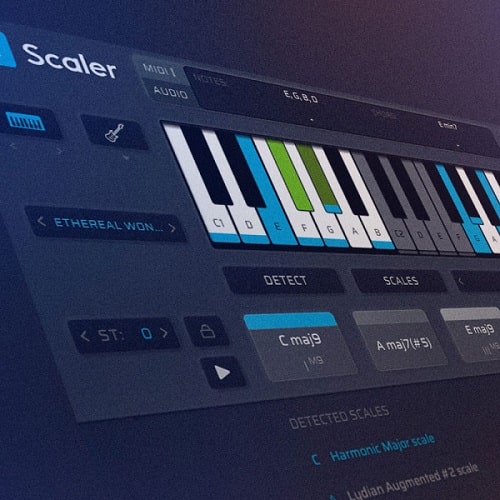
Producer’s Guide to Scaler 2 Course
Scaler 2 makes creating musical patterns simpler and more enjoyable than ever, with a hugely-expanded feature set and improved interface, which make the software even more flexible and fun to work with than the already popular version 1. In this comprehensive course from Producertech Senior Tutor Rob Jones, you’ll be taken through every part of the plugin, whilst creating chords patterns, basslines, leadlines and arpeggios, working in a number of different DAW setups.
The first 2 modules are a slow and steady journey through each of the main sections, to help familiarise students with the interface, whilst learning how to make simple but dynamic orchestral and synth chord progressions. Following on from this are a number of different workflow modules, showing how Scaler can be used in various situations, like creating chords to accompany a House groove, using a one-shot sample as the foundations for a track, and having Scaler detect the chords in a longer loop so it can be recreated and extended to form chords, leads, basslines and more!
The last workflow is a lengthy, realtime session, where Rob creates all the melodic parts in a retro-sounding Synthwave track, from a rhythmic bassline to swelling chords and psychedelic arp patterns. The arrangement is then expanded to include a section that modulates to a related key, as well as bridges made from Scaler chord suggestions, to help ease the flow of harmony from one section to the next.
Signing up to the course provides instant access to the streamed tutorials, as well as downloads of all the projects and samples featured in each module. Check out the free module excerpt for an example of the style and content before signing up to the course, which will have you creating luscious melodies and sweet harmonies in your music with Scaler 2 in no time!
Scaler 2 Course Breakdown
Module 1 – Course Introduction
Rob introduces the Course with a brief explanation of Scaler 2 and what it can do, as well as explaining how the modules are structured and the various subjects covered throughout the tutorial series.
Module 2 – Overview 1 – Creating a Staccato Strings Phrase in D Minor
In this first Overview Module, Rob works his way through Scaler, starting by choosing a scale and introducing sections as he goes, whilst building up a D minor triad chords progression, played by Orchestral Strings.
- Lesson 1 – Playing Scaler Sounds in Key with a MIDI or Computer Keyboard – 6.16
- Lesson 2 – Playing and Editing Simple Triad Chords – 6.56
- Lesson 3 – Exporting MIDI Patterns by Drag and Drop – 2.14
- Lesson 4 – Using Perform Mode Expressions – 3.26
- Lesson 5 – Customising Performance and Timing Settings – 2.32
- Lesson 6 – Using Humanize to create more Natural Phrases – 1.35
- Lesson 7 – Working with MIDI Capture – 2.53
- Lesson 8 – Transposing Patterns in the DAW – 1.09
Module 3 – Overview 2 – Creating some Classic Synth Breakdown Chords
In this second Overview Module, Rob begins again and takes a different path through Scaler, this time finding inspiration in the song presets to kick things off, whilst slowly building up a classic Synth Breakdown Chords Sequence.
- Lesson 1 – Creating Multiple Patterns with Song Presets – 3.27
- Lesson 2 – Editing Patterns and Individual Chords – 3.17
- Lesson 3 – Using Voice Grouping – 2.33
- Lesson 4 – Arpeggio Mode and Repeat Timing Customisation – 3.37
- Lesson 5 – DAW Sync – 1.16
- Lesson 6 – Using Chord Notes Keys Lock to Play Arp Patterns with a Keyboard – 3.21
- Lesson 7 – Exporting/Importing (Saving/Loading) Scaler Settings – 1.23
Module 4 – Workflow 1 – Making Chords and Accompaniment for a House Groove
Working to a House Beat and Bass Loop, Rob shows how Scaler can be used to come up with chords progressions and other rhythmic, melodic accompaniment.
- Lesson 1 – Creating and Capturing the Chords Pattern – 10.03
- Lesson 2 – Adding Additional Rhythmic Accompaniment – 9.46
Module 5 – Workflow 2 – Creating Parts from a Single Chord Oneshot Sample
Using Scaler 2’s new Audio Detection feature, Rob drags in a oneshot sample and uses that as the basis for a Chords Pattern, from which a bassline is also made. There is also a guide to using Scaler as a MIDI FX device rather than a regular instrument on a software instrument track in Logic.
Module 6 – Workflow 3 – Reconstructing Chords and Creating a Bassline from a Chords Sample
Starting with a longer Chords Loop Sample this time, Rob drags it into Scaler and then reconstructs the pattern so it can be used to play instruments in Logic. Several rhythmic variations are made, and different bassline options are demonstrated.
- Lesson 1 – Detecting the Sample and Creating the Chords Pattern – 15.16
- Lesson 2 – Making the Bassline – 4.36
Module 7 – Workflow 4 – Synthwave Arrangement Construction
This lengthier workflow builds up a Synthwave track from the ground up, starting with a rhythmic bassline and then adding swelling chords and descending arp lines. The arrangement is then fleshed out with a section that modulates to a related key, as well as shorter bridges to ease from one section to the next. This module starts by showing how to set up Ableton Live’s i/o options to play instruments with Scaler.
- Lesson 1 – Creating the Bassline – 12.47
- Lesson 2 – Making the Pad Chords Pattern and Adding Bass – 20.19
- Lesson 3 – Adding the Arp Lead – 8.07
- Lesson 4 – Changing Key and working out Bridges in the Modulation Area – 12.08
- Lesson 5 – Adding Bass and Lead to the Bridges – 14.18
